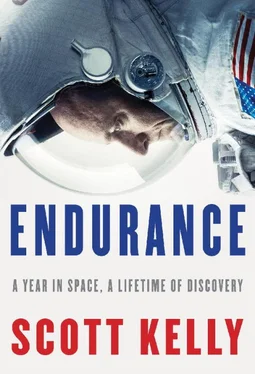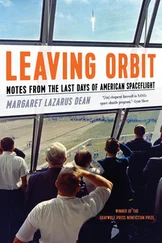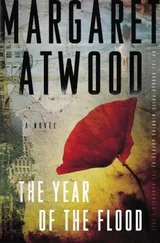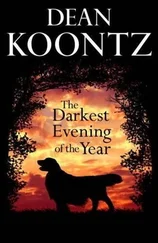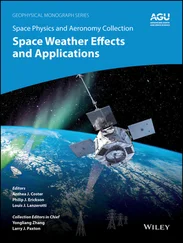“I can see Gabby in Gabby” is how Amiko put it, and she was right.
Less than two months later, I was standing next to Gabby on the roof of the Launch Control Center at Kennedy, watching Endeavour prepare to launch for its last mission, with Mark as its commander. Gabby had been to a space shuttle launch before, and of course I had been to many. It’s an experience that never gets old. The ground shakes, the air crackles with the power of the engines, and the rockets’ flames burn a searing orange in the sky. Seeing an object the size of a tall building lift itself straight up into the sky at supersonic speed is always moving, and when someone you know and care about is on board, it’s that much more so. There was a low cloud cover that day, and Endeavour punched up through it, lighting them up orange for a moment, then disappeared. Eight minutes later, it was in orbit around the Earth.
When Mark had decided he would see this mission through, Gabby had set the goal of being well enough to fly to Florida and see him off. That had been extremely ambitious, and she had done it. For Gabby, just being here was an accomplishment on par with a shuttle launch. She seemed to thrive on the challenge to do hard things.
—
SOON AFTER, the space shuttle was retired, fulfilling the terms of the Columbia Accident Investigation Board. I was sad to see it go. The shuttle was unique in its range of capabilities—heavy-lift cargo vehicle, science laboratory, orbiting service station for busted satellites. It was the spacecraft I’d learned to fly and learned to love, and I doubt we’ll see anything like it again in my lifetime.
In 2012, NASA learned the Russians were going to send a cosmonaut to the space station for a year. Their reasons were logistical rather than scientific, but once this had been decided, it put NASA in the position of having to either explain why an American astronaut was not up to the same challenge or announcing a yearlong mission themselves. To their credit, they chose the latter.
Once the Year in Space mission had been announced, NASA still had to choose the astronaut to do it. At first, I wasn’t sure I wanted it to be me. I remembered exactly how long 159 days on the space station had felt. I had spent six months at sea on an aircraft carrier and that was long; six months in space is longer. Spending twice as long up there wouldn’t just feel twice as long, I thought—it could be exponential. I knew I would miss Amiko and my daughters and my life on Earth. And I knew how it would feel if something bad happened to someone I loved while I was gone, because I had already experienced it. My father was getting up there in age and wasn’t in the greatest health.
But I had decided a long time before always to say yes to whatever challenge came my way. This yearlong mission was the hardest thing I’d ever have the opportunity to do, and after some reflection I decided I wanted to be the one to do it.
Many other astronauts also expressed interest. After all, spaceflight opportunities don’t come around every day. The requirements to be considered were many: we had to have previously flown a long-duration flight, we had to be certified to do spacewalks, we had to be capable of being assigned as commander, we had to be medically qualified, and we had to be available to be off the Earth for that year. With such a fine filter put on the requirements, in the end only two people qualified: Jeff Williams, one of my astronaut classmates, and me.
At around the same time, NASA was also looking to assign a new chief astronaut, because Peggy Whitson had stepped down in order to be eligible for the yearlong mission herself. I put my name in for the job of chief. In the interview, I was asked whether I would rather be chief of the Astronaut Office or fly in space for a year. Without hesitation, I said, “Chief of the Astronaut Office.” I thought there would be other opportunities to fly in space again, but maybe not another opportunity to serve as chief astronaut. My preference might have been considered, but the managers decided differently. A few weeks later, I learned I would be flying in space for a year.
Twenty-four hours after I was assigned, I was told that after further evaluation I had been medically disqualified and that Jeff would fly. On my previous mission I had experienced some damage to my eyes, and NASA didn’t want to take the risk of sending me up again. There could be some unexpected acceleration of the harmful effects after the six-month point, leaving me with permanent damage to my vision. I thought the danger was exaggerated, and I was disappointed, but I was resigned to the decision.
When I got home that night, I told Amiko about being medically disqualified. Rather than looking disappointed, as I expected, she looked puzzled.
“So they’re going to send someone who has been on two long flights and has not suffered vision damage?” she asked.
“Right,” I said.
“But if the point of this mission is to learn more about what happens to your body on a long mission,” she asked, “why would they send someone who is known to be immune to one of the things they intend to study?”
This was a good point.
“In all the time I’ve known you,” she said, “I have never seen you take no for an answer so easily.”
That night, after Amiko was asleep, I looked through my NASA medical records, an enormous pile of paper two feet high documenting years of data. I had experienced damage to my vision on my long-duration flight, but it had been mild and had returned to normal when I came back to Earth, though I still had some structural changes. Amiko was right: we could learn more about vision changes from someone like me than from someone who had demonstrated an immunity to the problem. I decided to present my case to management. They listened, and to my surprise they reversed their decision.
When I was preparing for the press conference to announce Misha and me as the one-year crew members, I asked what I thought was an innocent question about genetic research. I mentioned something we hadn’t previously discussed: Mark would be a perfect control to study throughout the year. It turns out my mentioning this had enormous ramifications. Because NASA was my employer, it would be illegal for them to ask me for my genetic information. But once I had suggested it, the possibilities of studying the genetic effects of spaceflight transformed the research. The Twins Study became an important aspect of the research being done on station. A lot of people have assumed that I was chosen for this mission because I have an identical twin, but that was just serendipitous.
The yearlong mission was announced in November 2012, with Misha and me as the crew.
—
THE IDEA of leaving the Earth for a year didn’t feel especially vivid until a couple of months before I was to go. On January 20, 2015, I attended the State of the Union Address at the invitation of President Obama. He was planning to mention my yearlong mission in his speech. It was an honor to sit in the House Chamber with the gathered members of Congress, the Joint Chiefs, the cabinet, and the Supreme Court. I sat in the gallery wearing my bright blue NASA flight jacket over a shirt and tie. The president described the goals of the yearlong mission—to solve the problems of getting to Mars—and called me out personally.
“Good luck, Captain!” he said. “Make sure to Instagram it! We’re proud of you.”
The assembled Congress got to their feet and applauded. I stood and gave an awkward nod and a wave. To see the government come together, even if only in a physical sense, was touching, and it was great to experience in person the bipartisan support NASA often enjoys.
Читать дальше
